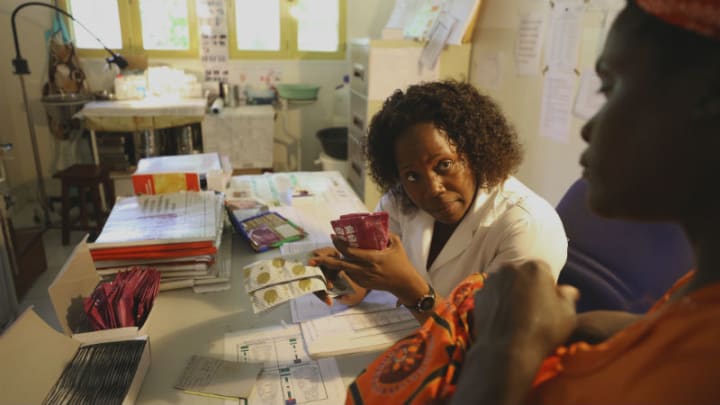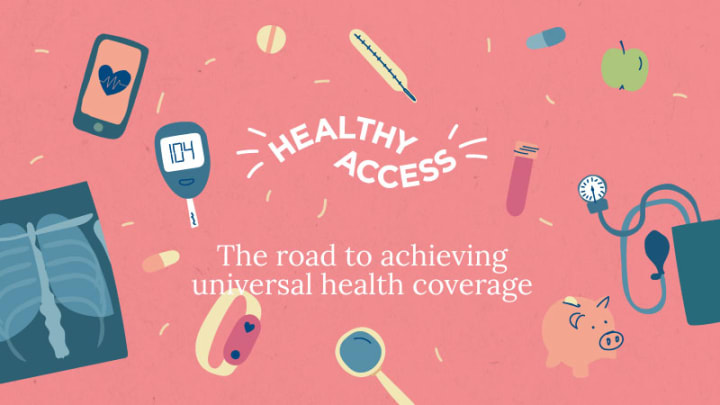
VANCOUVER — Increased financing, political leadership, and health systems strengthening are among the six political asks that UHC2030 — the global movement to build stronger health systems for universal health coverage — have created to feed into the United Nations High-Level Meeting on UHC in September.
But those asks don’t quite cover everything, according to Tanvi Monga, senior technical adviser of community engagement at Ipas — an international organization focused on expanding access to safe abortion and contraceptive care. So we have added a seventh ask, she said. Created by Women in Global Health and endorsed by the Alliance for Gender Equality in UHC — of which Ipas is a member — this ask focuses on achieving gender equality and providing access to sexual and reproductive health and rights for all by 2030.
“Our health systems, by primary design, are not designed to promote health; they are designed to respond to diseases.”
— Dr. Ademola Olajide, representative for Kenya, U.N. Population Fund“We firmly believe that SRHR — including safe abortion care — is not a vertical health service delivery mechanism,” Monga said. “It’s really an integral part of any health system and we’ll never achieve UHC without having SRHR as a critical component.”
SRHR covers physical, mental, and social well-being within sexual health, prevention of rape and forced marriage, access to reproductive health services, and the right to decide if and when to have children, as well as the freedom from discrimination, coercion, and violence when making family planning decisions.
Q&A: Peter Sands on what it takes to create effective health systems
"The pathway to UHC is not something you reach by investing in something called UHC," says the executive director of the Global Fund, Peter Sands.
Monga explained that if a woman or girl is able to access safe abortion services, it’s more likely she will finish her education, become a productive citizen, and contribute to the economic development of her country — all key components to achieving the Sustainable Development Goals.
Despite increased use of contraceptives, 214 million women living in low- and middle-income countries of reproductive age who want to avoid pregnancy are not using a modern contraceptive method. Reasons for this include limited access, fear of side effects, or gender-based barriers. 39,000 child marriages take place each day putting girls at risk of adolescent pregnancy and the consequential risk of maternal and infant morbidity and mortality. Three million girls aged 15-19 undergo unsafe abortions every year.
While the 2030 agenda acknowledges SRHR across the health, equality, and education goals, acute challenges remain in rallying support to address financing, say experts speaking on an SRHR panel at the Women Deliver conference earlier this month. In fact, the annual funding gap that needs to be bridged to eliminate preventable maternal, child, and adolescent deaths alone stands at $33 billion.
“Overall health service provision is really funded by donors, so even in the era of having prioritized UHC 2017-2018, the gap for family planning remains and a lot needs to be done,” said Pauline Irungu, advocacy and policy country lead for Kenya at international global health nonprofit PATH, during a session at Women Deliver.
If the use of contraceptives continues to increase, the need for more family planning products alone will create a funding gap of $322 million by 2020. While the private sector, multilaterals, and foundations have dedicated significant resources to SRHR, fluctuating exchange rates and political agendas threaten its continuity — creating a clear mandate for more domestic funding.
“For any country interested in achieving its development goals, they must invest in SRHR and make sure that everybody in that country can access services,” Irungu said.
Making financial decisions
One of the biggest challenges faced by SRHR advocates is that financial decisions on SRHR are usually made outside the health care system, said Dr. Ademola Olajide, U.N. Population Fund representative for Kenya.
“Those who make the financial decisions, make [them] purely based on their perception of what resources are required and what’s available to them,” Olajide said. “That creates a challenge in the sense that even our health systems, by primary design, are not designed to promote health; they are designed to respond to diseases.”
When a health issue is not directly life-threatening, Olajide said, that issue is often not prioritized in terms of resources.
In trying to overcome the financing barriers, increase domestic funding, and work to increase the access women and girls have to services such as contraception, safe abortion, and sexual health rights — and achieve UHC by 2030 — there are some actions those in the development sector can take:
1. Provide evidence and communicate it in the right way
While there must be partnerships, the primary investor in SRHR should be the government of that country, Irungo said, because it demonstrates how much that country values its people, sees them as a resource, and wants to invest in them.
Currently, donors and individuals are responsible for 49% of the costs of reproductive, maternal, neonatal, and children’s health with the remainder covered by governments and the private sector.
To encourage countries to become their own primary investor in SRHR, Olajide stressed the need for clear evidence on the return on investment in economic development as a result of investment in SRHR. While much of this already exists, Olajide said advocates must learn to communicate that evidence in a language that ministries of finance can understand, in order to encourage them to put up more domestic financing.
“The motivating factors that cause decisions to be made at that level are totally different, and so we must be able to crunch the evidence, and move beyond the rhetoric and the facts [and present] that evidence in a form that is useful,” he added.
How to address the midwife challenges threatening maternal care
What are the biggest challenges plaguing midwives globally? Does gender play a role? How can we safeguard maternal care? Devex asks the experts at this week's Women Deliver conference.
For example, when talking about pregnancies averted and appealing to a minister of finance, frame it as the unit cost of investment, Olajide said. “When we crunched the figures for Kenya, it was 15,500 Kenyan shillings ($150) for every live birth, against 700 shillings ($7) for family planning. Those are the kind of things you need to present.”
Ipas is working with partners such as the Clinton Health Access Initiative to develop more studies around why investments in SRHR and safe abortion care are worth being included as part of UHC.
2. Take a multisectoral and stakeholder approach
Taking that attitude of discussing SRHR beyond the health sector in each country is critical, said Monique Vledder, practice manager at the Global Financing Facility — an innovative financing mechanism contributing to closing the financing gap for the health and nutrition of women, children, and adolescents — adding that it’s essential that SRHR is very much a part of the comprehensive package of integrated UHC services.
“It’s really important to work in a more multisectoral framework, so we look at issues like women’s empowerment, ensuring girls can stay in school, and [have access to] menstrual hygiene, etcetera, to really make sure that it’s a comprehensive package to improve the lives of women and children, as well as their health,” Vledder said.
She also recommended that governments and civil society find a creative way to engage today’s youth so that financial support can better meet their needs.
“How can we give them voice to help determine what these services look like — which is really an important part of being successful in this agenda.”
3. Engage civil society in initial budget conversations
When countries are deciding on where their resources are going to be spent, civil society needs to be present to identify what is being prioritized for SRHR and give a voice to local communities, said PATH’s Irungu.
“If you look at the donor trend, there’s been a major shift over the years … donors are increasingly talking about country-owned and country-led, but for them to be country-owned it must be defined in a country document or plan,” she said.
After that, donors should be conscious of what the countries have prioritized, adhere to it, and discuss with countries and CSOs what should happen when the donors transition out. “That needs to be the beginning of any funding conversation,” Irungu said, explaining that too often everyone is caught up in creating programs rather than ascertaining how money works within existing government systems.
For example, GFF — a mechanism that uses grant resources to bring programs to scale by leveraging far greater sums of domestic government resources, International Development Association and International Bank for Reconstruction and Development financing, external financing, and resources from the private sector — requires countries invest significant domestic resources and are thinking long-term before they join GFF. They do this by working with GFF to identify priority investments, based on collated data, that they believe will help advance progress on the SDGs.
“The more donors can think about how to shift the future and work in that direction the better, and the civil society role of accountability needs to intensify,” Irungo said, adding that it is crucial to put in the necessary accountability mechanisms, build public education, and empower people so they can take their governments to task when a donor leaves.
However, GFF is not an easy thing to undertake, said Helga Fogstad, executive director of the Partnership for Maternal, Newborn & Child Health, a multiconstituency partnership hosted by the World Health Organization and chaired by Graça Machel, on the Women Deliver panel. “If we’re going to have civil society advocate for that, they need to understand how you align financing in a smart way, not only to get more financing but to better use existing financing. There’s a responsibility to use existing funding more prudently and better,” Fogstad said.
Update, June 25, 2019: This article has been updated to reflect the correct name of the Alliance for Gender Equality in UHC.
For a closer look at the innovative solutions designed to push for progress on universal health coverage around the globe, visit the Healthy Access series here.





